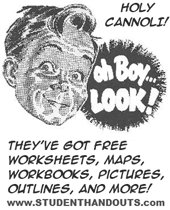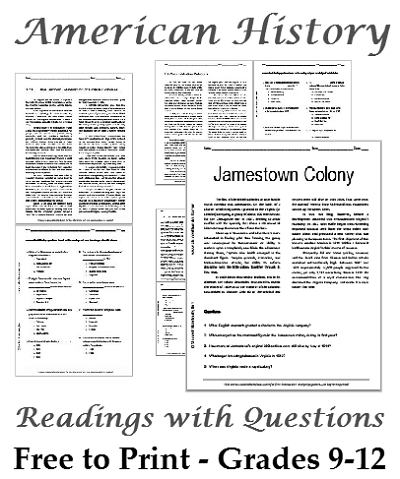| United States History Readings with Questions |
|---|
| studenthandouts.com ↣ United States History ↣ Printable American History Readings with Questions |
|
These worksheets, free to print, are designed for a comprehensive high school United States History course. There are 167 worksheets total, in chronological order, divided into fifteen sections. Each handout contains an informational text reading followed by a series of questions based on the reading. These are immensely popular with teachers, since they provide coherent, chronological informational texts without any need for a textbook. Most commonly, a teacher assigns one worksheet a night for homework (doubling up on the shorter worksheets), ensuring that students are prepared for the discussion, lecture, and extension activities the following day. For outlines, PowerPoints, and more for U.S. History, click here. Some, but not all, of these worksheets have interactive module versions. |
|
1. Early America 1. The First Americans 2. Mound Builders and Pueblos 3. Native-American Cultures 4. The First Europeans 5. Early Settlements - Module 6. Jamestown 7. Massachusetts 8. New Netherland and Maryland 9. Colonial-Indian Relations 10. Second Generation of British Colonies - Module 11. Settlers, Slaves, and Servants - Module 12. The Enduring Mystery of the Anasazi - Module |
2. The Colonial Period 1. New Peoples - Module 2. New England - Module 3. The Middle Colonies 4. The Southern Colonies - Module 5. Society, Schools, and Culture 6. Emergence of Colonial Government 7. The French and Indian War 8. An Exceptional Nation? 9. The Witches of Salem - Module |
|
3. Road to Independence 1. A New Colonial System 2. The Stamp Act - Module 3. Taxation without Representation - Module 4. The Townshend Acts - Module 5. Samuel Adams - Module 6. The Boston "Tea Party" - Module 7. The Coercive Acts - Module 8. The Revolution Begins - Module 9. Common Sense and Independence 10. Defeats and Victories 11. Franco-American Alliance - Module 12. The British Move South - Module 13. Victory and Independence - Module 14. The Significance of the American Revolution - Module |
4. Formation of a National Government 1. State Constitutions - Module 2. The Articles of Confederation - Module 3. The Problem of Expansion - Module 4. Constitutional Convention - Module 5. Debate and compromise 6. Ratification and the Bill of Rights 7. President Washington - Module 8. Hamilton vs. Jefferson - Module 9. Citizen Genet and Foreign Policy - Module 10. Adams and Jefferson - Module 11. Louisiana and Britain - Module 12. The War of 1812 - Module 13. The Second Great Awakening |
|
5. Westward Expansion and Regional Differences 1. Building Unity - Module 2. Extension of Slavery 3. Latin America and the Monroe Doctrine 4. Factionalism and Political Parties 5. Nullification Crisis 6. The Bank Fight 7. Whigs, Democrats, and Know-Nothings 8. Stirrings of Reform 9. Women's Rights 10. Westward 11. The Frontier, "The West," and the American Experience |
6. Sectional Conflict 1. Two Americas 2. Lands of Promise 3. Slavery and Sectionalism 4. The Abolitionists 5. Texas and War with Mexico 6. The compromise of 1850 7. A Divided Nation 8. Lincoln, Douglas, and Brown 9. The 1860 Election |
| 7. The Civil War and Reconstruction 1. Secession and Civil War 2. Western Advance, Eastern Stalemate 3. Gettysburg to Appomattox 4. With Malice toward None 5. Radical Reconstruction 6. The End of Reconstruction 7. The Civil War and New Patterns of American Politics |
8. Growth and Transformation 1. Technology and Change 2. Carnegie and the Era of Steel 3. Corporations and Cities 4. Railroads, Regulations, and the Tariff 5. Revolution in Agriculture 6. The Divided South 7. The Last Frontier 8. The Plight of the Native Americans 9. Ambivalent Empire 10. The Canal and the Americas 11. United States and Asia 12. J.P. Morgan and Finance Capitalism |
|
9. Discontent and Reform 1. Agrarian Distress and the Rise of Populism 2. The Struggles of Labor 3. The Reform Impulse 4. Roosevelt's Reforms 5. Taft and Wilson 6. A Nation of Nations |
10. War, Prosperity, and Depression 1. War and Neutral Rights 2. United States Enters World War I 3. The League of Nations 4. Postwar Unrest 5. The Booming 1920s 6. Tensions over Immigration 7. Clash of Cultures 8. The Great Depression |
|
13. Decades of Change: 1960-1980 1. The Civil Rights Movement, 1960-1980 2. The Women's Movement 3. The Latino Movement 4. The Native-American Movement 5. The Counterculture 6. Environmentalism 7. Kennedy and the Resurgence of Big Government Liberalism 8. Kennedy and the Cold War 9. The Space Program 10. Death of a President 11. Lyndon Johnson and the Great Society 12. The War in Vietnam 13. The Election of 1968 14. Nixon, Vietnam, and the Cold War 15. Nixon's Accomplishments and Defeats 16. The Ford Interlude 17. The Carter Years |
14. The New Conservatism and a New World Order 1. A Society in Transition 2. Conservatism and the Rise of Ronald Reagan 3. The Economy in the 1980s 4. Foreign Affairs 5. U.S.-Soviet Relations 6. The Presidency of George H.W. Bush 7. Budgets and Deficits 8. End to the Cold War 9. The Gulf War 10. Panama and NAFTA 11. Third-party and Independent Candidates |
| UNIT I: | Early America | UNIT IX: | Discontent and Reform | ||
| UNIT II: | Colonial Period | UNIT X: | War, Prosperity, and Depression | ||
| UNIT III: | American Revolution | UNIT XI: | New Deal and World War II | ||
| UNIT IV: | New National Government | UNIT XII: | Postwar America | ||
| UNIT V: | Westward Expansion | UNIT XIII: | Decades of Change | ||
| UNIT VI: | Sectional Conflict | UNIT XIV: | New Conservatism | ||
| UNIT VII: | Civil War and Reconstruction | UNIT XV: | Into the Twenty-first Century | ||
| UNIT VIII: | Growth and Transformation | UNIT XVI: | Polarization and Deglobalization |
| studenthandouts.com ↣ United States History ↣ Printable American History Readings with Questions |









